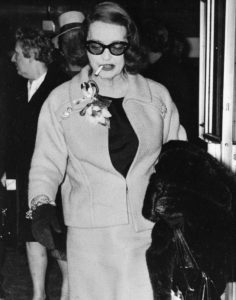
Artist-author James Thurber shown in Jan. 1940.
Forget making little dolls out of corn cobs or embroidering samplers with snippets of homey wisdom on them: If it’s a dying art you’re after, look to the news obituary.
Obit writers don’t get to witness wars or famine, attend Super Bowls, hang around briefing rooms, rub shoulders with the powerful — but we do get to immerse ourselves in other, perhaps more interesting lives.
After writing them for a few years before my retirement at the Los Angeles Times, I shed a tear when I think of news obits going the way of manual transmissions and environmental regulations. Not so long ago, a full-time staff of more than a half-dozen editors and writers – plus freelancers and a librarian — worked long hours putting together my former paper’s news obits. Now the department has been pared down to one beleaguered editor, who writes when he’s not busy seeking help from other overworked staffers.
It’s too bad. No other stories require such a quick, deep dive into fascinating lives. On deadline, obit writers race through dozens of clips, hurtle into dense biographies and make a frenzied volley of calls to their subjects’ colleagues, critics and mourning relatives, who often serve up unusable sparks of heartfelt reminiscence: “He was really a people person…At heart, she was really very shy…More than anything, he loved his family.”
Great obits are hard to do and harder to define — but they’re easy to spot. They’re concise, evocative and written with a sense of authority — even when writers like me, who flunked high school math, have to sketch out the career of geniuses like Nobel laureate John Nash. (I managed to explain Nash’s revolutionary “Nash equilibrium” in two simple sentences I just re-read and still don’t understand.)
Obits are often funny, because that’s life.

Actress Bette Davis in 1965.
Here’s Time magazine’s Richard Corliss on the 1989 death of Bette Davis:
“The frail, wee bird tottered onto Manhattan’s Lincoln Center stage last April, surveyed the gilded hall in which she was being paid tribute, and bellowed her famous line from Beyond the Forest: ‘What a dump!’ Even in her decrepitude, sapped by a stroke and the rodentoid cancer inside her, Bette Davis knew how to fill a room with her majestic arrogance.”
Ledes are everything in obits, whether they’re four-paragraph anecdotes or more traditional, just-the-facts-ma’am declaratory sentences. Often, they’re supplied by the irony or contradictions inherent in people’s lives. Here’s the top of an obit I wrote on an 89-year-old Texan who was acknowledged as the father of American cheerleading:
“When he was in high school, Lawrence Herkimer had a bad stutter. But when he was leading cheers for the football team, his elocution was perfect, his confidence unshakable, his destiny loud and proud.”
One of my favorite writers, James Thurber, was a great storyteller who, rambling entertainingly around his point, would have been terrible at day-to-day obits. As a young reporter who was continually nagged by his editor for punchier ledes, he topped a routine crime story with:
“Dead.
That’s what the man was when they found him with a knife in his back in front of Riley’s saloon at the corner of 52nd and 12th streets.”
Dead, of course, was how Thurber himself wound up at the age of 66 on Nov. 2, 1961.
When I was a teenager, I fell in love with Thurber, S.J. Perelman and the other great American humorists. Until recently, though, I’d never dipped into their obits.
The New York Times ran Thurber’s obit below the fold on a front page packed with news about fighting in Congo, a U.S. general’s angry resignation and a Teamsters’ strike that threatened to leave an ocean of milk stranded outside the city. Amazingly, the page had 15 stories — testament to the Times editors’ apparent faith in their readers’ ability to pick and choose.
The first quote in obits often is a tribute — something along the lines of, “He was a great mayor, a great man, and a great friend.” In Thurber’s case, the anonymous obit writer evokes Thurber and the spirit of the old New Yorker in a quote from Harold Ross, the magazine’s legendary editor. Criticized for hiring “a fifth-rate artist” like Thurber, Ross sprang to his charge’s defense. “You’re wrong,” he said. “Thurber is a third-rate artist.”
The Thurber piece had no byline. Today, everything in a newspaper but the school lunch menu gets a byline, but for years, newspapers treated them with more restraint. Bylines were seen as rewards (God knows, the pay wasn’t!) and editors professed disdain for writers who would seek to benefit from a death. In another reflection of a gentility that may have been outmoded even at the time, the story made no mention of Thurber’s struggles with alcohol or depression.
Like many funny writers, Thurber was not especially light of heart. When he was 6, his brother accidentally shot an arrow into his left eye. Thurber’s remaining eye started failing in his 40s. When the young Truman Capote was an office assistant at The New Yorker, one of his duties was to help the virtually blind Thurber get around. Capote later claimed that, helping Thurber dress after an afternoon romp with his girlfriend, he deliberately put the esteemed writer’s socks on inside-out to get him in trouble with his wife, Helen.
Although the Times obit didn’t offer such intimate details, it was almost as entertaining as Thurber himself.
“His tales were mingled with the exploits of unicorns, enraged wives, stupid athletes and excitable relatives,” the Times said. “His drawings of dogs, which he produced with abundance on the backs of envelopes, in telephone books, and on tablecloths, had a quality that seemed to link them with no other beast on earth.”
The first quote in obits often is a tribute — something along the lines of, “He was a great mayor, a great man, and a great friend.” In Thurber’s case, the anonymous obit writer evokes Thurber and the spirit of the old New Yorker in a quote from Harold Ross, the magazine’s legendary editor.
Criticized for hiring “a fifth-rate artist” like Thurber, Ross sprang to his charge’s defense.
“You’re wrong,” he said. “Thurber is a third-rate artist.”
When it came to describing Thurber’s most famous short story, “The Secret Life of Walter Mitty,” the Times writer, remarkably, stepped out of the way and let Thurber himself take the helm for the next six paragraphs:
“‘We’re going through!’ The commander’s voice was like thin ice breaking. He wore his full-dress uniform with the heavily braided cap pulled down rakishly over one cold, gray eye.
“‘We can’t make it, sir. It’s spoiling for a hurricane if you ask me.’
“‘I’m not asking you Lieutenant Berg,’ said the commander. ‘Throw on the power lights! Rev her up to 8,500! We’re going through!’
“The pounding of the cylinders increased: ta-pocketa-pocketa-pocketa-pocketa…
” ‘Not so fast! You’re driving too fast!” said Mrs. Mitty. ‘What are you driving so fast for?'”
“‘Hummmm?’ said Walter Mitty. He looked at his wife, in the seat beside him, with shocked astonishment…”
That’s just the way it is in Obits. Obit writers don’t get to witness wars or famine, attend Super Bowls, hang around briefing rooms, rub shoulders with the powerful — but we do get to immerse ourselves in other, perhaps more interesting lives.
Ta-pocketa-pocketa-pocketa-pocketa….


